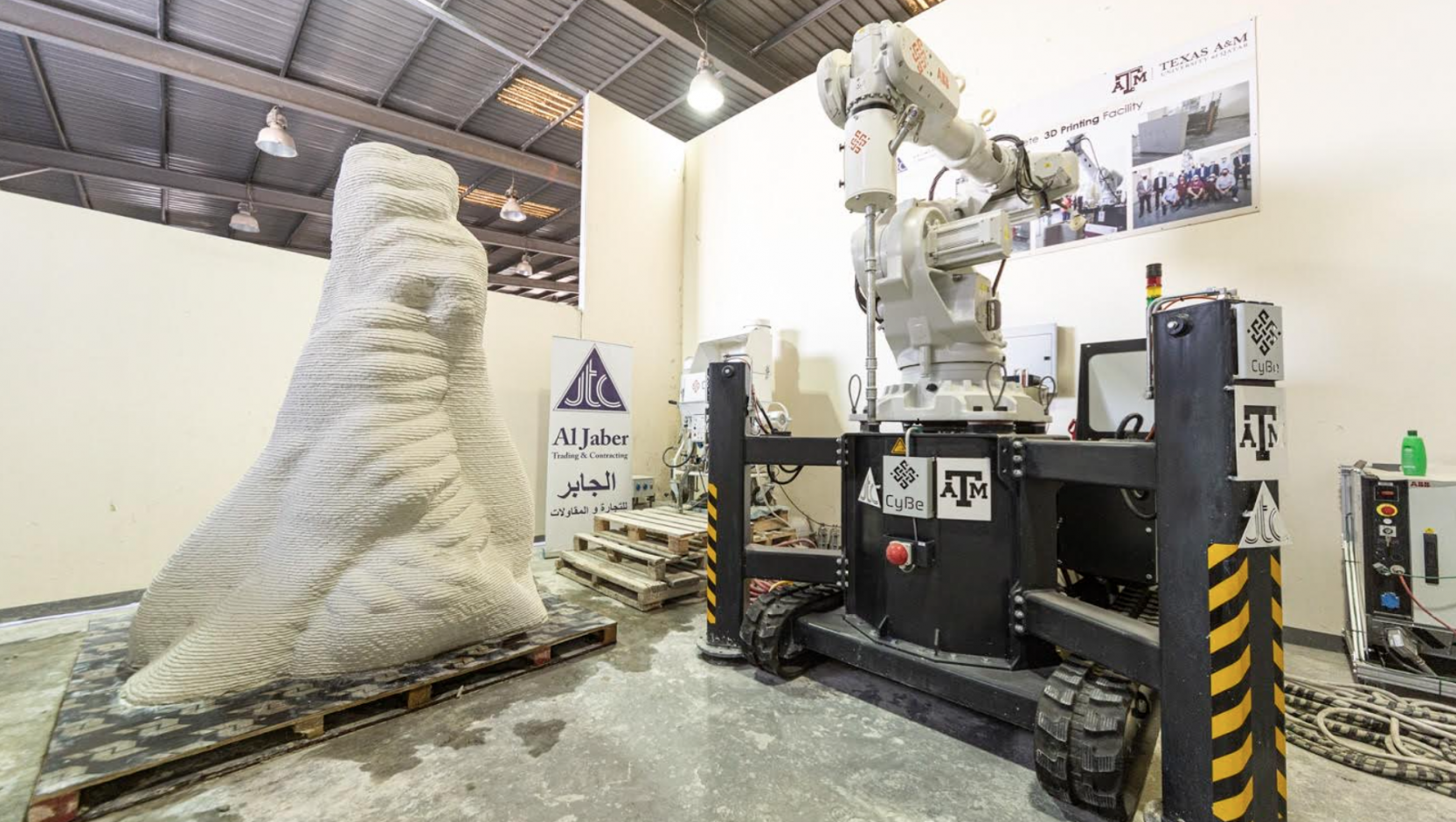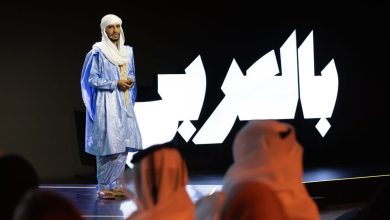Qatar’s first concrete 3D sculpture printed in a few minutes
أول منحوتة في قطر مصنوعة بتقنية الطباعة ثلاثية الأبعاد
QNA
Doha: The country’s first 3D printed concrete structure is a local favourite – the Flag of Glory sculpture — a representation of diverse hands united in holding up the flag of Qatar. It was printed in Qatar’s only facility for concrete 3D printing, established as a result of a partnership between Texas A&M University at Qatar, a Qatar Foundation partner university, Al Jaber Trading and Contracting (JTC), and Cybe Construction.
3D printing has received increasing attention in the past decade, some industries found success in it early on, others like the construction industry struggled to catch up until very recently. Several 3D printed concrete structures are now popping up around the world.
Qatar has recently joined this international movement with its first 3D-printed concrete structure. “We choose to print this particular sculpture because of its significance to the country, and the diversity it symbolises,” said Dr. Eyad Masad, Professor in the Mechanical Engineering Program at Texas A&M University at Qatar (TAMUQ), who was critical in bringing concrete 3D printing technology to Qatar.
“From a technical aspect, this sculpture offers us the opportunity to showcase one of the biggest advantages of 3D printing which is flexibility in geometry.
With a structure like this, conventional construction practices would require designing and making a mould first, 3D printing allows us to skip that step completely allowing considerable cost savings.” Engr. Mohammed Al Hamayda, JTC’s General Manager, said: “TAMUQ and JTC operators are now fully trained to 3D print any complex object using concrete locally.
Our ultimate mutual goal is to participate effectively in developing green construction practices in Qatar in line with its National Vision 2030. The possibilities with 3D printing are endless and we look forward to partnering with the public and private construction sector as well as academic institutions to deliver rapid and sustainable construction in Qatar.”
3D concrete printing is an alternative construction method that has the potential to revolutionize the construction industry globally, with significant benefits such as reduced manpower; greater geometric freedom; reduced material consumption and wastage; improved safety on-site.
The ultimate goal of the group is to use demolished waste from construction and recycle it back into the construction sector through 3D printing. This work is currently being conducted with funding support from QF’s Qatar National Research Fund (QNRF) and in partnership with QF’s Hamad Bin Khalifa University (HBKU), Al-Jaber Trading and Contracting, Ashgal, Seero Engineering, and Hecettepe University in Turkey.
On the research side of the technology, experts from TAMUQ are looking into developing local materials for printing. “If you want to print structures in Qatar, you need to produce the printing material in Qatar. Shipping it is not a sustainable o p t i o n a l , n e i t h e r economically nor environmentally,” said Dr. Masad.
A major material property to focus on for construction in a country like Qatar is thermal conductivity. The group is currently exploring printing with a light material that has low thermal conductivity so it can provide insulation and essentially create smart structures. As of now, no regulations exist in Qatar to get 3D printed buildings approved for residential or commercial use.
To make inhabitable 3D printed buildings a reality, the government would need to develop electrical, plumbing, structural integrity, and public safety code standards. Dr. Masad noted that TAMUQ and JTC have worked very hard for the past year and a half to adopt this technology in Qatar.
The learning curve leading up to the deployment was a steep one, the team had to learn the design process, familiarize themselves with the printing material and its properties, understand how the printer operates and train personnel.
He said: “We are pleased to say, we have successfully managed to integrate all this knowledge and are now confident in our ability to deliver 3D printed concrete structures for Qatar.” Standing at a height of almost three meters, the structure took only 30 minutes to print and required two personnel to monitor the printing, and add the printing material.
The same structure, if constructed using conventional methods, would have taken 12 to 18 hours and at least five people.
قنا
الدوحة: تعتبر منحوتة “راية المجد” المعروفة محليا، أول هيكل خرساني في قطر مصنوع بتقنية الطباعة ثلاثية الأبعاد، وقد طبعت هذه المنحوتة، التي تمثل أياد متعددة ومتحدة في رفع علم قطر، في المنشأة المحلية الوحيدة التي توفر الطباعة ثلاثية الأبعاد للخرسانة، والتي تأسست نتيجة شراكة بين جامعة تكساس إيه آند إم في قطر، إحدى الجامعات الشريكة لمؤسسة قطر، وشركة الجابر للتجارة والمقاولات، وشركة سايب كونستركشين.
وحظيت الطباعة ثلاثية الأبعاد باهتمام متزايد خلال العقد الماضي، وحققت بعض القطاعات فيها نجاحات مبكرة، بينما تأخرت قطاعات أخرى، مثل قطاع الإنشاءات، في الاستفادة منها حتى وقت قريب جدا، وفي الوقت الحالي، ظهرت العديد من الهياكل الخرسانية المصنوعة بتقنية الطباعة ثلاثية الأبعاد في جميع أنحاء العالم، وانضمت قطر مؤخرا إلى هذا التوجه الدولي من خلال أول هيكل خرساني مطبوع بهذه التقنية.
ويقول الدكتور إياد مسعد، أستاذ الهندسة الميكانيكية في جامعة تكساس إيه آند إم في قطر، والذي شدد على أهمية تكريس تقنية الطباعة ثلاثية الأبعاد إلى قطر: “اخترنا طباعة هذه المنحوتة بسبب أهميتها والتنوع الذي ترمز إليه، ومن الناحية التقنية، تمنحنا هذه المنحوتة فرصة عرض إحدى أكبر مزايا الطباعة ثلاثية الأبعاد، وهي المرونة الهندسية، إذ تتطلب أساليب البناء التقليدية، لصنع هيكل كهذا، تصميم القالب وصنعه أولا، بينما تتيح لنا الطباعة ثلاثية الأبعاد تخطي هذه الخطوة كليا، مما يقلل التكاليف بشكل كبير”.
بدوره، قال المهندس محمد الحمايدة، المدير العام لشركة الجابر للتجارة والمقاولات: “أجرى فريق شركة الجابر للتجارة والمقاولات، وجامعة تكساس إيه آند إم في قطر، تدريبا شاملا على استخدام الطباعة ثلاثية الأبعاد، وهم قادرون على صناعة أي غرض معقد محليا باستخدام الخرسانة، نسعى في نهاية المطاف إلى المساهمة بشكل فعال في تطوير ممارسات البناء الأخضر في قطر بما يتماشى مع رؤيتها الوطنية 2030، إذ تتمتع الطباعة ثلاثية الأبعاد بإمكانيات لا حصر لها، ونتطلع إلى عقد شراكات مع القطاعين العام والخاص، ومع المؤسسات الأكاديمية لتوفير بناء سريع ومستدام في قطر”.
وتعد الطباعة الخرسانية ثلاثية الأبعاد طريقة بناء بديلة، وذات قدرة على إحداث ثورة في قطاع الإنشاءات على مستوى عالمي، كما تتميز بإيجابيات كبيرة مثل تقليل الحاجة إلى الأيدي العاملة، وزيادة الحرية في التصاميم الهندسية، وتقليل استهلاك المواد وهدرها، وزيادة مستوى السلامة في موقع البناء.
ويسعى الفريق إلى امتلاك القدرة على استخدام المخلفات الناتجة عن الهدم، وإعادة تدويرها مرة أخرى في قطاع الإنشاءات من خلال الطباعة ثلاثية الأبعاد، ويجري العمل على ذلك بتمويل من الصندوق القطري لرعاية البحث العلمي، عضو مؤسسة قطر، وبالشراكة مع جامعة حمد بن خليفة، عضو مؤسسة قطر، وشركة الجابر للتجارة والمقاولات، وهيئة الأشغال العامة، وشركة سيروا للاستشارات الهندسية، وجامعة حجة تبة في تركيا.
من جهتهم، يعمل خبراء من جامعة تكساس إيه آند إم في قطر، على تطوير مواد محلية للطباعة، ويشرح الدكتور مسعد: “إذا كنت تسعى لطباعة الهياكل في قطر، فأنت بحاجة إلى إنتاج مواد الطباعة محليا، فالشحن ليس خيارا مستداما من الناحية الاقتصادية أو البيئية”.
كذلك يجري الفريق حاليا دراسات على الطباعة باستخدام مادة خفيفة ذات موصلية حرارية منخفضة، تكون قادرة على توفير العزل وإنشاء هياكل ذكية، إذ تعد الموصلية الحرارية لمادة البناء إحدى أهم الخصائص الرئيسية الواجب دراستها في بلد مثل قطر.
لا توجد، حتى الآن، قوانين في قطر لاستخراج إذن للبناء باستخدام الطباعة ثلاثية الأبعاد لأغراض سكنية أو تجارية، ومن المتوقع أن تعمل الجهات الرسمية المعنية على تطوير معايير وقوانين تحدد الشروط الواجب توفرها في هذه المباني من حيث الكهرباء، السباكة، السلامة الهيكلية، السلامة العامة، وغيرها.
ويشير الدكتور مسعد إلى أن اعتماد هذه التكنولوجيا لم يكن أمرا سهلا، حيث عملت جامعة تكساس إيه آند إم في قطر، وشركة الجابر للتجارة والمقاولات، بجد على مدى عام ونصف من أجل ذلك، وكان على الفريق تعلم عملية التصميم، والتعرف على مواد الطباعة وخصائصها، وفهم كيفية عمل الطابعة، وتدريب الموظفين، ويقول: “يسعدنا القول إننا نجحنا في اكتساب هذه المعارف، نحن الآن واثقون من قدرتنا على أن نقدم لقطر هياكل خرسانية مصنوعة بتقنية الطباعة ثلاثية الأبعاد”.
استغرقت طباعة الهيكل، الذي يبلغ ارتفاعه ثلاثة أمتار تقريبا، 30 دقيقة فقط للطباعة، وتطلب الأمر شخصين فقط لمراقبة الطباعة وإضافة مواد الطباعة، ولو تم تشييده باستخدام الطرق التقليدية، لاستغرق من 12 إلى 18 ساعة، بمشاركة خمسة أشخاص على الأقل.
وتعليقا على التحدي الأكبر في الطباعة ثلاثية الأبعاد للخرسانة، يوضح الدكتور مسعد: “يتمثل التحدي التقني الأكبر في تطوير مادة طباعة ذات خصائص محسنة، بحيث يخرج الخليط سائلا دون أن يجف داخل الآلة فيعطلها، لكنه في الوقت نفسه قابل للجفاف بسرعة بعد صبه بحيث يحافظ على الشكل المنشود”.




